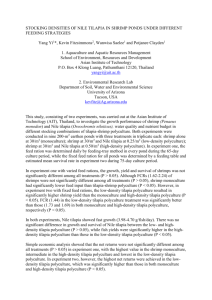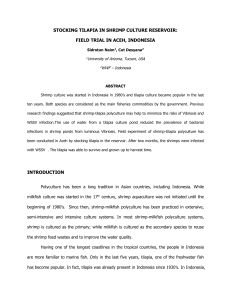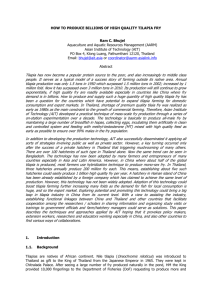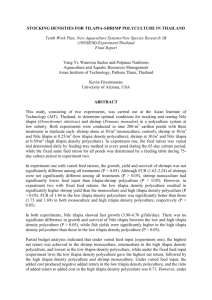TILAPIA: SILENT BOOMING IN BANGLADESH PowerPoint
advertisement
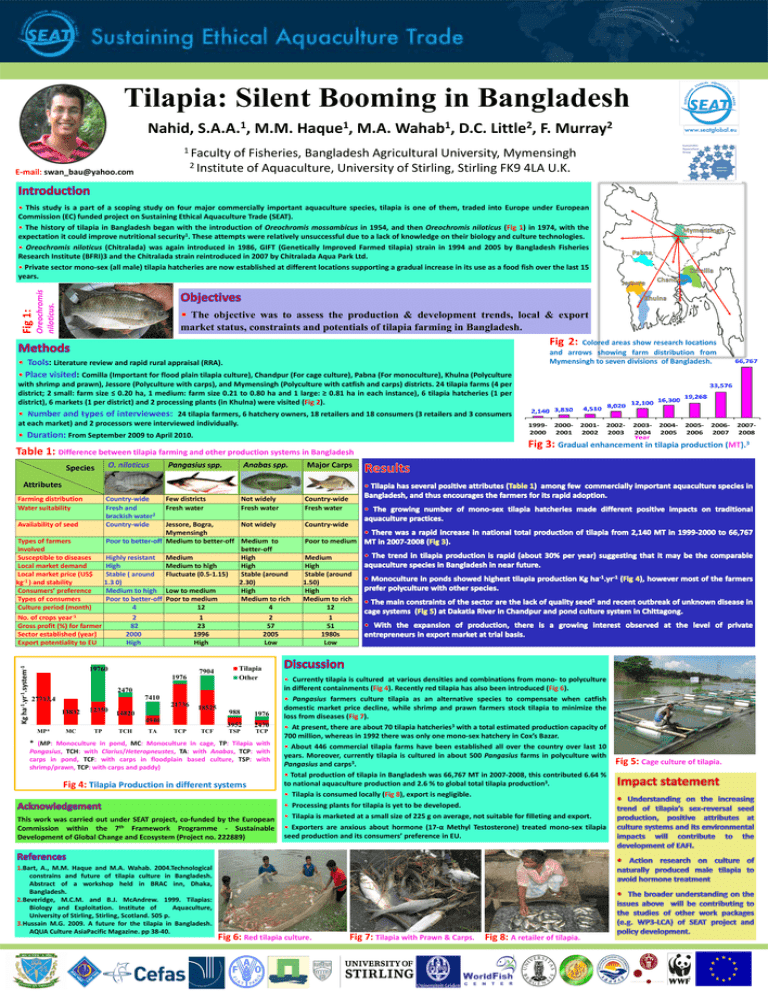
Tilapia: Silent Booming in Bangladesh Nahid, 1 S.A.A. , M.M. 1 Haque , M.A. 1 Wahab , D.C. 2 Little , F. 2 Murray 1 Faculty of Fisheries, Bangladesh Agricultural University, Mymensingh 2 Institute of Aquaculture, University of Stirling, Stirling FK9 4LA U.K. E-mail: swan_bau@yahoo.com Oreochromis niloticus. Fig 1: This study is a part of a scoping study on four major commercially important aquaculture species, tilapia is one of them, traded into Europe under European Commission (EC) funded project on Sustaining Ethical Aquaculture Trade (SEAT). The history of tilapia in Bangladesh began with the introduction of Oreochromis mossambicus in 1954, and then Oreochromis niloticus (Fig 1) in 1974, with the expectation it could improve nutritional security1. These attempts were relatively unsuccessful due to a lack of knowledge on their biology and culture technologies. Oreochromis niloticus (Chitralada) was again introduced in 1986, GIFT (Genetically Improved Farmed tilapia) strain in 1994 and 2005 by Bangladesh Fisheries Research Institute (BFRI)3 and the Chitralada strain reintroduced in 2007 by Chitralada Aqua Park Ltd. Private sector mono-sex (all male) tilapia hatcheries are now established at different locations supporting a gradual increase in its use as a food fish over the last 15 years. The objective was to assess the production & development trends, local & export market status, constraints and potentials of tilapia farming in Bangladesh. Fig 2: Colored areas show research locations and arrows showing farm distribution from Mymensingh to seven divisions of Bangladesh. Tools: Literature review and rapid rural appraisal (RRA). Place visited: Comilla (Important for flood plain tilapia culture), Chandpur (For cage culture), Pabna (For monoculture), Khulna (Polyculture with shrimp and prawn), Jessore (Polyculture with carps), and Mymensingh (Polyculture with catfish and carps) districts. 24 tilapia farms (4 per district; 2 small: farm size ≤ 0.20 ha, 1 medium: farm size 0.21 to 0.80 ha and 1 large: ≥ 0.81 ha in each instance), 6 tilapia hatcheries (1 per district), 6 markets (1 per district) and 2 processing plants (in Khulna) were visited (Fig 2). Number and types of interviewees: 24 tilapia farmers, 6 hatchery owners, 18 retailers and 18 consumers (3 retailers and 3 consumers at each market) and 2 processors were interviewed individually. Table 1: Difference between tilapia farming and other production systems in Bangladesh O. niloticus Pangasius spp. Anabas spp. Major Carps Country-wide Fresh and brackish water2 Country-wide Few districts Fresh water Not widely Fresh water Country-wide Fresh water Species 33,576 2,140 3,830 19992000 Duration: From September 2009 to April 2010. 20002001 16,300 12,100 4,510 8,020 20012002 20022003 20032004 Year 20042005 19,268 20052006 20062007 Availability of seed Jessore, Bogra, Not widely Mymensingh Poor to better-off Medium to better-off Medium to better-off Highly resistant Medium High High Medium to high High Stable ( around Fluctuate (0.5-1.15) Stable (around 1.3 0) 2.30) Medium to high Low to medium High Poor to better-off Poor to medium Medium to rich 4 12 4 Types of farmers involved Susceptible to diseases Local market demand Local market price (US$ kg-1 ) and stability Consumers’ preference Types of consumers Culture period (month) Kg ha-1.yr-1.system-1 No. of crops year-1 Gross profit (%) for farmer Sector established (year) Export potentiality to EU 2 82 2000 High 1 23 1996 High 19760 1976 7904 Tilapia Other 2470 7410 27713.4 13832 12350 21736 14820 18525 4940 MP* MC TP TCH TA TCP TCF Country-wide Poor to medium Medium High Stable (around 1.50) High Medium to rich 12 2 57 2005 Low 988 1976 3952 2470 TSP TCP * (MP: Monoculture in pond, MC: Monoculture in cage, TP: Tilapia with Pangasius, TCH: with Clarius/Heteropneustes, TA: with Anabas, TCP: with carps in pond, TCF: with carps in floodplain based culture, TSP: with shrimp/prawn, TCP: with carps and paddy) Fig 4: Tilapia Production in different systems 1 51 1980s Low Currently tilapia is cultured at various densities and combinations from mono- to polyculture in different containments (Fig 4). Recently red tilapia has also been introduced (Fig 6). Pangasius farmers culture tilapia as an alternative species to compensate when catfish domestic market price decline, while shrimp and prawn farmers stock tilapia to minimize the loss from diseases (Fig 7). At present, there are about 70 tilapia hatcheries3 with a total estimated production capacity of 700 million, whereas in 1992 there was only one mono-sex hatchery in Cox’s Bazar. About 446 commercial tilapia farms have been established all over the country over last 10 years. Moreover, currently tilapia is cultured in about 500 Pangasius farms in polyculture with Pangasius and carps3. Total production of tilapia in Bangladesh was 66,767 MT in 2007-2008, this contributed 6.64 % to national aquaculture production and 2.6 % to global total tilapia production3. Tilapia is consumed locally (Fig 8), export is negligible. Processing plants for tilapia is yet to be developed. This work was carried out under SEAT project, co-funded by the European Commission within the 7th Framework Programme - Sustainable Development of Global Change and Ecosystem (Project no. 222889) 1.Bart, A., M.M. Haque and M.A. Wahab. 2004.Technological constrains and future of tilapia culture in Bangladesh. Abstract of a workshop held in BRAC inn, Dhaka, Bangladesh. 2.Beveridge, M.C.M. and B.J. McAndrew. 1999. Tilapias: Biology and Exploitation. Institute of Aquaculture, University of Stirling, Stirling, Scotland. 505 p. 3.Hussain M.G. 2009. A future for the tilapia in Bangladesh. AQUA Culture AsiaPacific Magazine. pp 38-40. Tilapia is marketed at a small size of 225 g on average, not suitable for filleting and export. Exporters are anxious about hormone (17-α Methyl Testosterone) treated mono-sex tilapia seed production and its consumers’ preference in EU. Fig 6: Red tilapia culture. 20072008 Fig 3: Gradual enhancement in tilapia production (MT).3 Attributes Farming distribution Water suitability 66,767 Fig 7: Tilapia with Prawn & Carps. Fig 8: A retailer of tilapia. Fig 5: Cage culture of tilapia.




